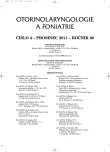Chirurgická léčba nosní polypózy
Část II.: Prognostický význam tkáňové eozinofilie
Authors:
B. Gál 1; P. Rotterová 2
Authors‘ workplace:
Patologicko-anatomický ústav FN U sv. Anny, Brno
; Klinika otorinolaryngologie a chirurgie hlavy a krku FN u sv. Anny, Brno
; přednosta prof. MUDr. R. Kostřica, CSc.
1; přednostka doc. MUDr. M. Hermanová, Ph. D.
2
Published in:
Otorinolaryngol Foniatr, 60, 2011, No. 4, pp. 186-191.
Category:
Original Article
Overview
In a study group of 94 patients operated on for bilateral nasal polyposis in the Department of Otorhinolaryngology and Head and Neck Surgery of St. Anne’ University Hospital Brno between 1998 and 2005, tissue eosinophilia was determined from polyp tissue samples. The mean value of tissue eosinophilia was 38. Eo/HPF (Me 32.5, Q0,25, Q0,75 = 14, 58). In a control group of 12 patients, tissue eosinophilia was determined from tissue samples of the inferior turbinate mucosa and in all samples the value was <3 Eo/HPF. Through analysis of a histogram curve of eosinophil infiltration intensity of patients in the follow-up study group, a tissue eosinophilia threshold value of 40Eo/HPF was determined and the patients were divided into two subgroups. In the first subgroup of patients with a value of eosinophilia up to 40Eo/HPF, there was a markedly lower percentage of recurrence (about 8%) in comparison with the second subgroup of patients with tissue eosinophilia higher than 40 Eo/HPF where recurrence occurred in more than half of patients (53%).The median value of the recurrence-free interval was significantly lower in the group of patients with higher tissue eosinophilia (33 months) as compared with the second group (51 months). There was also a significant difference in the degree of tissue eosinophilia in patients without risk factors (Me=14 Eo/HPF) in comparison with patients with allergy and/or bronchial asthma (Me=39Eo/HPF) and patients with ASA sensitivity (Me=56Eo/HPF). Moreover, in patients with allergy and/or asthma and patients with ASA sensitivity it was possible to select, in connection with tissue eosinophilia, patients with a significantly higher risk of NP recurrence. According to Kaplan–Meier analysis, the probability of NP recurrence 5 years after surgery in patients with allergy and/or asthma and with lower eosinophilia (<40 Eo/HPF) was 8%, in the group of patients with allergy and/or asthma and with higher eosinophilia (> 40 Eo/HPF) 42%, in patients with ASA sensitivity and lower eosinophilia 14%, and in patients with ASA sensitivity and higher eosinophilia 69%. Thus it has been proved that determination of tissue eosinophilia is of predictive significance and it can valuably contribute to the assessment of postoperative NP recurrence risk and thereby to the determination of an appropriate postoperative management.
Key words:
nasal polyps, tissue eosinophilia, surgical treatment, recurrence rate, allergy, bronchial asthma, ASA sensitivity.
Labels
Audiology Paediatric ENT ENT (Otorhinolaryngology)Article was published in
Otorhinolaryngology and Phoniatrics

2011 Issue 4
Most read in this issue
- Orbitocellulitis and Its Therapy at the Child Age
- Transconjunctival Approach to Blow-out Fractures of Orbit in Children
- Vocal Fold Augmentation by Autologous Fat – First Experience and Preliminary Results
-
Chirurgická léčba nosní polypózy
Část III.: Symptomatické hodnocení efektu operace
